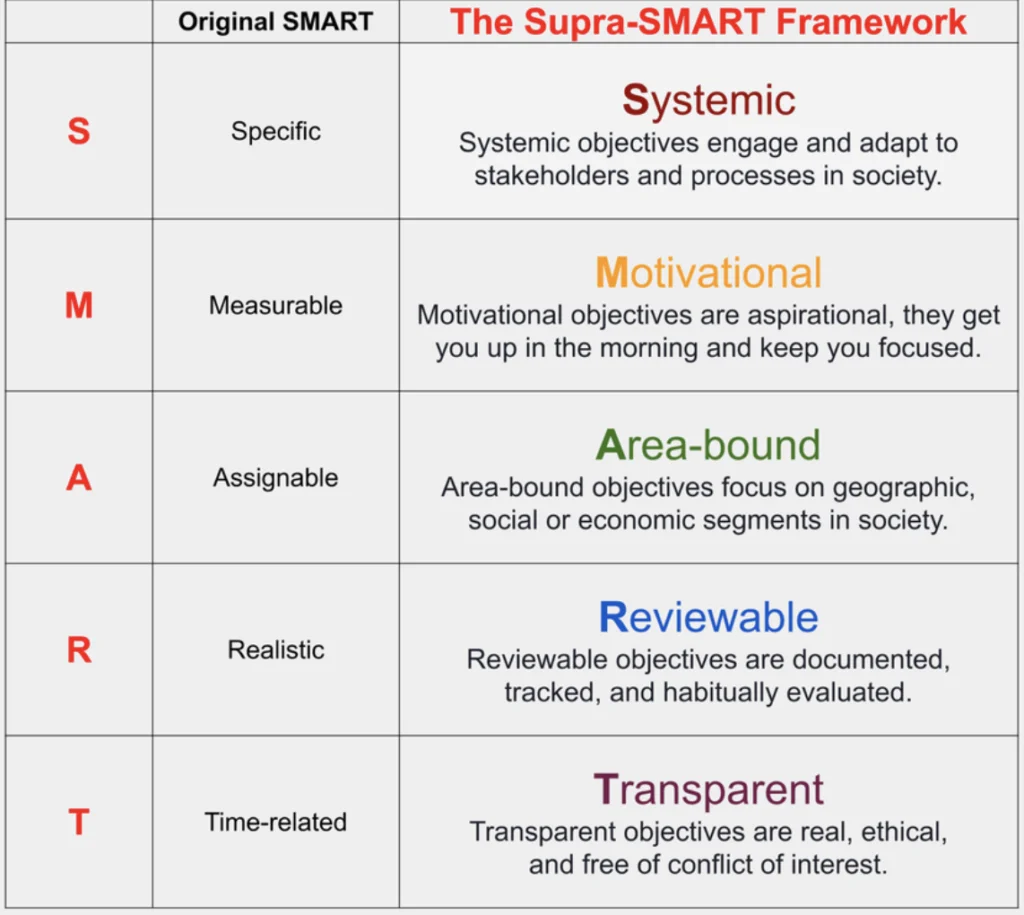Introduction
Setting objectives focused on value based healthcare is demanding. You’re working in a field that is complex and involves multiple processes and stakeholders, and you’re trying to shape objectives that help with expanding value based healthcare in constructive ways.
You’re weighing the value story of a new healthcare technology, learning how value based healthcare works, incorporating the value evidence, and then figuring out how to develop productive objectives.
To start, it’s important to reflect on your achievements from previous years.
- What did you achieve?
- Did you contribute a solution to strengthen a value based healthcare system?
- Did you reach your targets?
- What did you not achieve, and why?
Your preferred approach to develop objectives was probably the SMART way of writing objectives.

The SMART way to write management goals and objectives
Did you know that the SMART way of writing goals first appeared in November 1981? George Doran developed the approach published in Management Review (a copy is available here).
The original SMART has transformed in 38 years.
- The A changed to “Achievable” or “Attainable”.
- R became “Relevant”.
- T became “Time-bound” or “Timely”.
These variations result in different interpretations of the original SMART. The only consistent application of the original SMART is the SM, everything after that is negotiable.
Another shortcoming is the limited questions it deals with. Doran tailored the approach for questions on what (specific, measurable, and realistic), who (assignable), and when (time-related). The original SMART overlooks why, how, and where to pursue the objective.
The original SMART also needs an external who, i.e. with whom to work on the objective. These weaknesses may clarify why many clients find it demanding setting objectives focused on value based healthcare systems!
The Supra-SMART Framework, a better way to make value based healthcare work
We developed our own Framework to overcome weaknesses in the original SMART. We call it the Supra-SMART Framework and it’s a better way to make value based healthcare work.
The Supra-SMART Framework is a parallel structure overlaid on the original! It can set personal and company objectives. It also answers questions related to why, how, where, and with whom.

The Supra-SMART Framework supplements the original SMART to refine your objectives. For example, the latter may define micro-level, personal, or annual objectives, while the Supra-SMART Framework could help with macro-level, organizational, and long-term objectives.
The Supra-SMART Framework helps focus your objectives on specific social and economic groups in a society that would benefit from the new healthcare technology. Or, you could use the Supra-SMART Framework to articulate the value story in a reviewable and transparent way. Why is the value in the new healthcare technology important and how does it support a value based healthcare system?
A Practical example with the Supra-SMART Framework
Background
Company X launched a new healthcare technology 2 years ago indicated for multiple myeloma patients. Multiple myeloma is a rare and aggressive cancer associated with a high morbidity and mortality. Company X’s new healthcare technology entered a market with 8 other products from 6 competing companies. Company Y is the market leader with a 55% market share derived from 2 technologies confronted by generic alternatives.
Patient advocacy groups, regulators, payors, and prescribers express concern with the value that new healthcare technologies bring to the market. They are also concerned with the cost and the unmet clinical needs among multiple myeloma patients. At the time of launch, Company X developed a market access strategy comprising SMART objectives that included cross-functional responsibilities. However, these objectives have not delivered meaningful market uptake over 2 years, and Company X is unsure whether they are concentrating on the key success factors.
Next Steps
Company X is committed to setting objectives focused on a value based healthcare approach. They recognize that the current market access strategy requires a relevant value story, so Company X adopts the Supra-SMART Framework. The first step is a comprehensive review of the market system and setting objectives that engage and adapt to stakeholders. Company X’s activities are not simple bidirectional relationships, but a multidirectional network of processes and entities.
The next step is including motivational and area-bound elements in the objectives. This requires a clear delineation of the beneficiaries of the new healthcare technology and an alignment with their aspirations. It’s important at this stage to differentiate commercial aspirations from the beneficiaries’ aspirations.
The next step is ensuring the objectives are reviewable. This is routine in Company X through periodic reviews of staff performance. However, Supra-SMART objectives are collaborative and sometimes produced with market stakeholders. It’s fundamental that Company X document, track, and evaluate the objectives.
The last step is including transparency in the Supra-SMART objectives. Are Company X’s objectives real, ethical, and free of conflicts of interest? Company X’s internal policies and management review can help but soliciting stakeholder feedback will also highlight gaps.
We support implementing the Supra-SMART Framework
The Supra-SMART Framework enhances ordinary objectives by answering additional questions on why, how, where, and with whom. It is challenging to set and achieve goals when working on value based healthcare.
The Supra-SMART Framework refines your market access strategy and helps you focus on key success factors. If you need support in implementing the Supra-SMART Framework, reach out. We’re only a call or email away. Here’s to your Supra-SMART objectives!
Table of Contents
